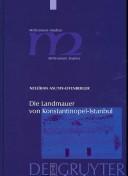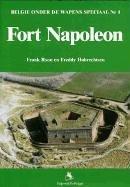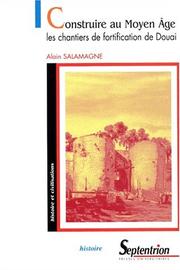| Listing 1 - 10 of 10 |
Sort by
|
Book
ISBN: 140735924X Year: 2022 Publisher: Oxford, UK : BAR Publishing,
Abstract | Keywords | Export | Availability | Bookmark
 Loading...
Loading...Choose an application
- Reference Manager
- EndNote
- RefWorks (Direct export to RefWorks)
This text studies the archaeological remains of the endogenous fortifications of eastern Senegal during the Atlantic slave trade. In his first part, he addresses the generalities by dealing with the determinants of the establishment of fortifications in West Africa. Following a proposal for the classification of West African endogenous fortifications, it gives an overview of the different types of fortifications present from Senegal to Cameroon. In the second part, he presents the military and political history of the state entities of the left bank of the Falémé (the Fulani kingdom of Boundou, and the Malinké kingdoms of Dantila, Sirimana, and Beledougou), as well as the defensive structures that served as the basis for this history. As much as possible, each ruin of fortifications is studied under an archaeological and historical approach.
Fortification --- Slave trade --- History. --- Fortification, Primitive --- Forts --- Military engineering --- Siege warfare

ISBN: 1282196065 9786612196065 3110203995 311019645X Year: 2008 Publisher: Berlin/Boston De Gruyter
Abstract | Keywords | Export | Availability | Bookmark
 Loading...
Loading...Choose an application
- Reference Manager
- EndNote
- RefWorks (Direct export to RefWorks)
Die Landmauer von Konstantinopel gehört zu den bedeutendsten und größten Wehranlagen der Spätantike. Die vorliegende Arbeit behandelt die Baugeschichte und Topographie der Theodosianischen Landmauer und der Blachernen-Mauer (sog. Mauer der XIV. Region, Komnenen-Mauer, Mauerabschnitt zwischen Komnenen-Mauer und Goldenem Horn). Schwerpunkte bilden das theodosianische Baukonzept der Doppelmauer, die Anzahl der theodosianischen Türme, die zeitliche Einordnung des Goldenen Tors und des Rahmenwerks am Vortor, die Baugeschichte der Tore, die Ermittlung der byzantinischen Namen der Tore zwischen dem wiederentdeckten Romanos-Tors und Edirnekapı, die Lokalisierung des Polichnion von Kaiser Ioannes V. Palaiologos (Mermerkule), die Identifizierung weiterer Örtlichkeiten im Bereich der Theodosianischen Mauer (Polyandrion, Myriandrion, Mesoteichion), die Topographie und Baugeschichte der Komnenen-Mauer einschließlich der Identifikation der Tore der Blachernen-Mauer sowie das Problem der letzten Kaiserresidenz von Konstantinopel (Tekfur Sarayı). In weiteren Abschnitten werden das Mauerwerk dokumentiert und untersucht und ein Katalog der Spolien vorgelegt. Zwei Exkurse widmen sich dem spätbyzantinischen Straßensystem von Konstantinopel und zwei Istanbul-Karten von Piri Reis.
City walls --- Fortification --- Fortification, Primitive --- Forts --- Military engineering --- Siege warfare --- Village walls --- Walls --- Architecture. --- Building Technology. --- Constantinople. --- Istanbul.

ISBN: 9058680142 9789058680143 Year: 2000 Volume: 16 Publisher: Erpe-Mere De Krijger
Abstract | Keywords | Export | Availability | Bookmark
 Loading...
Loading...Choose an application
- Reference Manager
- EndNote
- RefWorks (Direct export to RefWorks)
History of Belgium and Luxembourg --- Steendorp --- Public buildings --- Ostend --- Fortifications --- Oostende --- Ostende --- Verdedigingswerken --- Antwerpen (stad) --- Anvers (ville) --- 725.182 --- #A0012A --- 581 Monumentenbescherming, cultureel erfgoed --- Versterkingskunst. Forten. Vestingen --- 725.182 Versterkingskunst. Forten. Vestingen --- Fortification --- Fortification, Primitive --- Forts --- Military engineering --- Siege warfare --- Fort Steendorp (Temse, Belgium) --- Temse (Belgium) --- Fort Rupelmonde (Temse, Belgium) --- History, Military. --- Geschichte 1792-1996. --- Belgium --- Fort Napoleon (Ostend, Belgium). --- Ostend (Belgium) --- Fort Napoleon.

ISBN: 2903189331 2918887501 9782903189334 Year: 2016 Volume: 13 Publisher: Naples : Publications du Centre Jean Bérard,
Abstract | Keywords | Export | Availability | Bookmark
 Loading...
Loading...Choose an application
- Reference Manager
- EndNote
- RefWorks (Direct export to RefWorks)
Fortification --- Greeks --- Excavations (Archaeology) --- Caulonia (Italy) --- Antiquities. --- Archaeological digs --- Archaeological excavations --- Digs (Archaeology) --- Excavation sites (Archaeology) --- Ruins --- Sites, Excavation (Archaeology) --- Archaeology --- Ethnology --- Mediterranean race --- Fortification, Primitive --- Forts --- Military engineering --- Siege warfare --- Castelvetere (Reggio di Calabria, Italy) --- Italie --- fouille archéologique --- Kaulonia --- Antiquité --- fortifications
Book

ISBN: 273512648X 9782735126484 9782735111190 2735111199 2910023788 Year: 2006 Volume: 100 Publisher: Pessac Cedex (Bordeaux) Paris Ausonius. Maison de l'Archéologie. Université Michel de Montaigne - Bordeaux 3 Editions de la Maison des sciences de l'homme
Abstract | Keywords | Export | Availability | Bookmark
 Loading...
Loading...Choose an application
- Reference Manager
- EndNote
- RefWorks (Direct export to RefWorks)
Soixante-dix ans après le tome 1 du Manuel d’archéologie galloromaine d’Albert Grenier, Michel Reddé, Raymond Brulet, Rudolf Fellmann, Jan Kees Haalebos et Siegmar von Schnurbein proposent une nouvelle synthèse sur l’architecture militaire romaine dans les provinces des Gaules et des Germanies. La première partie analyse les différents types de constructions et de techniques observées dans les camps militaires, en replaçant l’évolution de cette architecture dans son contexte historique, de la conquête de la Gaule au milieu du Ve s. ap. J.-C. La seconde partie est un catalogue qui, sans prétendre à l’exhaustivité, présente les sites incontournables et d’autres moins connus, notamment en France. Chaque notice, bien documentée et toujours illustrée, est assortie d’une bibliographie. Cet ouvrage est le fruit d’une collaboration internationale à laquelle plus de cinquante auteurs ont été associés. Il s’adresse à des étudiants et à des chercheurs non spécialisés, qui y trouveront des informations commodes, à jour, rassemblées pour la première fois. This work is the outcome of international cooperation involving J over fifty authors. It is aimed at an audience of undergraduates and non-specialist researchers, who will find it useful for the conveniently packaged, up-to-date information gathered together for the first time Seventy years after the publication of Volume 1 of Albert Grenier’s Manuel d’archéologie gallo-romaine, Michel Reddc, Raymond Brulet, Rudolf Fellmann, Jan Kces Haalebos and 5iegmar von Schnurbein have prepared a new overview of Roman military architecture in the provinces of Gaul and Germania. The first part analyzes the different types of construction techniques observed in military camps, placing the development of this architecture within its historical context, from the conquest of Gaul to the middle of the fifth century AD. The second part is a catalogue which, while making no claim to be exhaustive, presents all the key sites alongside other…
Fortification --- Romans --- Excavations (Archaeology) --- History. --- France --- Gaul --- Antiquities, Roman. --- Fortification, Primitive --- Forts --- Military engineering --- Siege warfare --- Fortification - France - History. --- Romans - France. --- Excavations (Archaeology) - France. --- Fortification, Roman --- Military architecture --- Fortifications romaines --- Architecture militaire --- Fouilles (Archéologie) --- architecture militaire --- Gaule --- frontière --- enceinte --- Haut Empire --- Bas Empire --- fortification --- armée romaine --- Germanie --- limes --- Archeology --- Roman history
Book
ISBN: 1785700294 1785700278 9781785700279 9781785700293 9781785700286 1785700286 178570026X 9781785700262 1789256526 Year: 2016 Publisher: Oxford : Oxbow Books,
Abstract | Keywords | Export | Availability | Bookmark
 Loading...
Loading...Choose an application
- Reference Manager
- EndNote
- RefWorks (Direct export to RefWorks)
"Between 1975 and 1984 almost the entire area of the Roman fort of Segedunum in Wallsend was excavated under the direction of Charles Daniels, senior lecturer in the Department of Archaeology at Newcastle University. It is these excavations which form the subject of this publication. This comprehensive report on the structural remains (Vol. 1) and finds (Vol. 2) show clearly that Daniels' work represented one of the most ambitious and prolonged programs of fieldwork attempted on the northern frontier up to that point and has made Wallsend one of the most fully investigated of Roman forts in Britain. In most areas the remains were not excavated down to natural and so the remains revealed were predominantly those of the 2nd and 3rd centuries, with some late Roman features. Volume 1 describes first the stratigraphic sequences and excavation of the stone and timber buildings of the fort's central range: the granary, hospital, headquarters (principia), commanding officer's house (praetorium), the forehall fronting the principia and granary, and a long narrow building, perhaps a workshop, on the north side of the eastern via principalis. In the case of all but the praetorium these buildings were fully exposed. Later chapters cover the buildings in the northern third of the fort, revealed to be a group of six infantry barracks which underwent several phases of rebuilding and refurbishment including partial replacement by a stable block. Parts 4 and 5 examine the cavalry barracks in the southern part of the fort (retentura) and excavations of sections of the fort defenses on all four sides, particularly of discrete structures such as towers and gates. Volume 2, on the predominantly 2nd-3rd century material culture from the site, looks at the stonework, pottery, coins and small finds recovered. The stonework and ceramic building material provides information on the appearance of the fort and include a very rare stone latrine seat and a bench support. The pottery comprises samian, mortaria, including a large collection stamped by Anaus, amphorae and coarse wares. Other classes of artifact occur in comparatively small numbers, including colorless glass tablewares of the second and third centuries, 295 coins and c. 1000 small finds including some post-Roman pieces. Finally there is a detailed assessment of animal bone assemblages from a cistern and the Commanding Officer's house"--Publisher's summary.
Excavations (Archaeology) --- Fortification --- Material culture --- Animal remains (Archaeology) --- Fortification, Primitive --- Forts --- Military engineering --- Siege warfare --- Archaeological digs --- Archaeological excavations --- Digs (Archaeology) --- Excavation sites (Archaeology) --- Ruins --- Sites, Excavation (Archaeology) --- Archaeology --- Archaeozoology --- Zooarchaeology --- Zoology in archaeology --- Bones --- Animal paleopathology --- Culture --- Folklore --- Technology --- Methodology --- Segedunum Roman Fort Site (Wallsend, England) --- Wallsend (England) --- Wallsend Roman Fort Site (Wallsend, England) --- England --- Antiquities, Roman. --- Antiquities --- Fortification, Roman --- Fortifications romaines --- Fouilles (Archéologie) --- Culture matérielle --- Restes d'animaux (Archéologie) --- Wallsend (Angleterre) --- Antiquities, Roman --- Antiquités romaines
Book
ISBN: 9789058264688 9789058264848 Year: 2007 Publisher: Leuven Davidsfonds
Abstract | Keywords | Export | Availability | Bookmark
 Loading...
Loading...Choose an application
- Reference Manager
- EndNote
- RefWorks (Direct export to RefWorks)
History of Europe --- Archeology --- anno 1910-1919 --- Intrenchments --- National cemeteries --- World War, 1914-1918 --- Geografie --- Battlefields --- Landschapskunde --- Historische geografie --- België. --- 949.3.034 --- 581 Monumentenbescherming, cultureel erfgoed --- 944 Eerste Wereldoorlog --- BPB0804 --- C5 --- Wereldoorlog I --- herinner --- getuigen --- Geschiedenis van België: 1ste wereldoorlog (1914-1918) --- Maatschappelijke organisaties en maatschappelijk leven --- 949.3.034 Geschiedenis van België: 1ste wereldoorlog (1914-1918) --- zwart-wit fotografie --- Photography --- Military cemeteries and funerals --- Military parks --- Entrenchments --- Foxholes --- Trench warfare --- Fortification --- Military field engineering --- Obstacles (Military science) --- Siege warfare --- zwart-witfotografie --- Military cemeteries --- Cemeteries

ISBN: 2859396357 2757422081 9782859396350 Year: 2001 Volume: *33 Publisher: Villeneuve-d'Ascq: Presses universitaires du Septentrion,
Abstract | Keywords | Export | Availability | Bookmark
 Loading...
Loading...Choose an application
- Reference Manager
- EndNote
- RefWorks (Direct export to RefWorks)
L’industrialisation du xixe siècle a oblitéré la mémoire du Nord : le sud du département fut cependant jusqu’à la Révolution un grand centre européen de production de la pierre : des carrières de l’Ostrevant – région située entre Douai et Valenciennes – des centaines de chariot convoyaient jusqu’aux chantiers douaisiens ou valenciennois la pierre de grès dont les chargements remontaient encore sur de lourdes péniches la Scarpe ou l’Escaut pour alimenter, de Gand à Utrecht, les grandes villes flamandes ou brabançonnes. À travers l’exemple des chantiers de fortification de Douai, l’auteur évoque la politique d’une ville des anciens Pays-Bas en matière de construction. Exploitant un ensemble de sources inédites, il retrace la genèse des fortifications, situe leur place dans l’histoire de l’art et étudie l’organisation et les techniques de construction dans une ville médiévale. La richesse de la documentation rassemblée permet de souligner l’activité exemplaire du bâtiment dans ces régions des anciens Pays-Bas qui explique et annonce – avec son avance technologique – l’essor industriel du xixe siècle.
Architecture, Medieval --- City walls --- Architecture médiévale --- Murs d'une ville --- Douai (France) --- Buildings, structures, etc. --- Constructions --- Fortification --- History. --- -Fortification --- -725.182 --- 944.28 DOUAI --- Fortification, Primitive --- Forts --- Military engineering --- Siege warfare --- Middle Ages --- Versterkingskunst. Forten. Vestingen --- Geschiedenis van Frankrijk: dép. du Nord--(reg./lok.)--DOUAI --- -History --- 944.28 DOUAI Geschiedenis van Frankrijk: dép. du Nord--(reg./lok.)--DOUAI --- 725.182 Versterkingskunst. Forten. Vestingen --- Architecture médiévale --- -Douai --- Douay (France) --- Doway (France) --- Dovay (France) --- History --- 725.182 --- Douai --- Architecture [Medieval ] --- France --- Architecture, Medieval - France - Douai. --- Fortification - France - Douai. --- histoire --- construction --- chantier --- fortification --- pierre --- technologie
Book
ISBN: 2735104397 2735120619 9782735104390 Year: 1992 Volume: 33 Publisher: Paris: Maison des sciences de l'homme,
Abstract | Keywords | Export | Availability | Bookmark
 Loading...
Loading...Choose an application
- Reference Manager
- EndNote
- RefWorks (Direct export to RefWorks)
À partir d’un inventaire exhaustif des résidences fortifiées confrontant la documentation écrite, les témoignages figurés et l’étude de terrain, est retracée l’évolution de l’habitat seigneurial du Xe au XVe siècle. Celui-ci est réinséré dans son terroir et dans son contexte social grâce, entre autres, à l’établissement de généalogies inédites. Imposant, ce travail maintient un rapport constant entre passé et présent, montrant le cheminement de la recherche archéologique et abordant des problèmes actuels, tel celui de la protection de ce patrimoine menacé. An exhaustive inventory of fortified residences is compared here to written evidence, figurative representations and fieldwork. It retraces the evolution of seigneurial residences of the Xth to XVth centuries. These elements are reinsered into the domaine and social context thanks to the drawing up of unpublished genealogies. In this imposing work a continual contact is maintained between past and present outlining the progress of archaeological research. Actual problems such as the protection of this threatened heritage are also evoked here.
Fortification --- Castles --- Excavations (Archaeology) --- 728.82 <44> --- -Castles --- -Excavations (Archaeology) --- -Archaeological digs --- Archaeological excavations --- Digs (Archaeology) --- Excavation sites (Archaeology) --- Ruins --- Sites, Excavation (Archaeology) --- Archaeology --- Châteaux --- Feudal castles --- Architecture --- Architecture, Medieval --- Fortification, Primitive --- Forts --- Military engineering --- Siege warfare --- Kastelen--Frankrijk --- Lorraine (France) --- -Lorraine (France) --- -Antiquities --- Genealogy --- -Kastelen--Frankrijk --- 728.82 <44> Kastelen--Frankrijk --- Archaeological digs --- Lothringen (France) --- Alsace-Lorraine (Germany) --- Lorraine (Duchy) --- Bar (Duchy) --- Lorraine (Territory under German Occupation, 1940-1944) --- Antiquities. --- Genealogy. --- Grand Est (France) --- Fortification - France - Lorraine. --- Castles - France - Lorraine. --- Excavations (Archaeology) - France - Lorraine. --- Moyen Âge --- château --- habitat seigneurial --- Lorraine --- maison forte
Book
ISBN: 9782735111206 2735111202 9782735120772 2735120775 Year: 2020 Volume: 102 Publisher: Paris : Éditions de la Maison des sciences de l’homme,
Abstract | Keywords | Export | Availability | Bookmark
 Loading...
Loading...Choose an application
- Reference Manager
- EndNote
- RefWorks (Direct export to RefWorks)
Deux décennies de recherches sur les mottes castrales de Provence ont apporté des éléments nouveaux sur le phénomène castral qui s’est développé dès la fin du xe siècle. Plus de soixante sites ont été répertoriés et la prospection continue à en révéler de nouveaux. Les fouilles de plusieurs d’entre eux ont permis d’établir une évolution dans les modes d’organisation et de construction de ces petits châteaux. À l’origine, ce furent des établissements très modestes, simples maisons perchées qui nécessitaient assez peu de moyens et des techniques faciles à mettre en œuvre. Dans un second temps, dès l’an Mil toutefois, on relève la construction de véritables forteresses. L’étude de ces premières fortifications s’intéresse à l’occupation des terroirs qui s’organisèrent autour du castrum, souvent mentionné dans les textes. La construction de ces fortifications semble intense autour de l’an Mil et au cours du xie siècle mais certaines ont été érigées au début du xiiie siècle. Les recherches se poursuivent et montrent que les débuts de la fortification privée s’insèrent dans un vaste mouvement d’occupation des terroirs autour de fortifications aux caractères complexes. Two decades of research on Motte-and-Bailey castles in Provence have contributed new elements to our knowledge of the castle phenomenon that developed at the end of the 10th century. More than sixty sites have been recorded and our prospection continues to reveal new ones. The excavation of several of them allowed us to identify the evolution of construction methods and the organization of these small castles. In the beginning, they were very modest edifices consisting of simple perched houses that required relatively few resources and employed techniques that were easy to put into operation. In the second phase, beginning around 1000 AD, we observe the construction of true fortresses. The study of these first fortifications focuses on the occupation of terroirs organized around a castrum, often noted in…
Fortification --- Excavations (Archaeology) --- Military architecture --- Fortifications --- Fouilles (Archéologie) --- Architecture militaire --- Provence-Côte d'Azur (France) --- Antiquities. --- History. --- Antiquités --- Histoire --- Châteaux forts --- Archéologie médiévale --- Provence (France) --- Antiquités. --- Histoire. --- Provence-Côte d'Azur (France) --- Antiquities --- Fouilles (Archéologie) --- Antiquités --- Châteaux forts --- Archéologie médiévale --- Antiquités. --- Architecture --- Architecture and war --- Military engineering --- Archaeological digs --- Archaeological excavations --- Digs (Archaeology) --- Excavation sites (Archaeology) --- Ruins --- Sites, Excavation (Archaeology) --- Archaeology --- Fortification, Primitive --- Forts --- Siege warfare --- Provence-Côte d'Azur, France --- Provence-Alpes-Côte d'Azur (France) --- Provence-Côte d'Azur-Corse (France) --- Fortification - France - Provence-Côte d'Azur --- Excavations (Archaeology) - France - Provence-Côte d'Azur --- Military architecture - France - Provence-Côte d'Azur --- Provence-Côte d'Azur (France) - Antiquities --- habitat --- Moyen Âge --- château --- fortification --- église --- militarisation --- motte castrale --- occupation du territoire --- voie --- kernmotte --- sala
| Listing 1 - 10 of 10 |
Sort by
|

 Search
Search Feedback
Feedback About
About Help
Help News
News